Healthy and Delicious Sweet Corn Paratha
July 17, 2014 by admin
Filed under Parathas-Chapathi
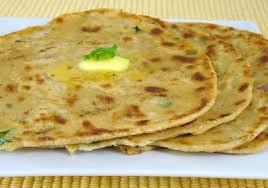 Sweet corns are available during winter days. In monsoon people usually have corn roasted by at road side vendors. Sweet corn is mostly steamed and eaten with a garnish of lime juice and salt. Sweet corn is full of vitamins and fiber. Sweet corn can be included in your wheat dough to make delicious sweet corn paratha.
Sweet corns are available during winter days. In monsoon people usually have corn roasted by at road side vendors. Sweet corn is mostly steamed and eaten with a garnish of lime juice and salt. Sweet corn is full of vitamins and fiber. Sweet corn can be included in your wheat dough to make delicious sweet corn paratha.
Here’s the recipe for sweet corn paratha also referred to as Makai ki roti.
Ingredients for Sweet Corn Paratha:
- Wheat flour: 2cups
- Sweet corn: 1 cup
- Green chilly: 2 nos ( chopped finely)
- Coriander leaves: 3 tsp (finely chopped)
- Ajwain ( Carom seeds or Bishop’s weed): ¼ tsp
- Ginger-garlic paste: ¼ tsp
- Cooking oil / Ghee: 4 tbsp
- Salt: as per taste
- Water: as required
Procedure for preparing Sweet Corn Paratha:
Method:
- Remove the corn from the cob and grind in the mixer to form a smooth paste.You can even grate the cob and remove the pulp.
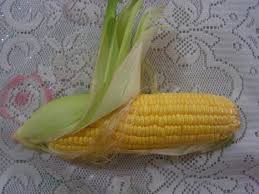
- Add the sweet corn pulp into the dough along with 1 tbsp of oil.Knead the flour to form a hard flour.
- Cover the dough with a wet cloth and let it remain for 20 to 30 mins. The dough will become fluffy and will set.
- Smoothen the dough by kneading for a few minutes.
- Make small rolls (size of a lemon} and roll the dough with a rolling pin. Dip the balls into wheat flour to avoid sticking to the base.
- Put 2 drops of oil a little wheat flour and fold the paratha at 1/3 length. Place the other 1/3rd length over the first fold. Fold both the open end one over the other like a handkerchief.
- Dip the dough into wheat flour and with a rolling pin to make a thick paratha. Make sure the spread is even i.e not too thick nor thin.
- Heat a tawa / pan and apply little oil on the pan. Place the paratha on the pan. When one side is heated flip the paratha.
- Apply oil / ghee on the top side. Flip the paratha and apply oil on the second side too.
- Maintain low heat to avoid burning of paratha. You will observe the paratha is golden brown color indicating it has cooked.
- Prepare the sweet corn parathas with the remaining dough and place it in a hot pack-casserole or serve them hot.
A good combination with green peas curry, kaju curry,mixed vegetable curry. You can also Makai ki roti serve with raitha, pickle or chutney.
Delicious and healthy Sweet Corn Paratha is ready to serve. You will enjoy the taste and also benefit with the vitamins and fibers that are within the Sweet corn. The aroma of carom seeds and the flavors while making the parathas will increase your appetite.
Please add a comment and, if you like the post, feel free to share it with your friends.
Chatpati Chammandhi for Idli-Dosa
July 8, 2014 by admin
Filed under Chutney varieties
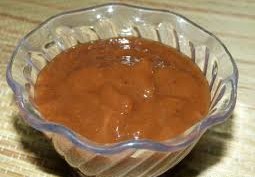 Chammandhi or chutney is an essential part of a menu in South Indian homes in addition to Sambhar. There are several varieties of Chutneys and Sambars made in South India.
Chammandhi or chutney is an essential part of a menu in South Indian homes in addition to Sambhar. There are several varieties of Chutneys and Sambars made in South India.
The recipe I’m sharing today is a chatpati chutney loved by my kids and they empty the tiffin box clean. Chatpati Chammandhi is a great combination with Idli-dosa. My son shares his tiffin box and his friends also have given me compliments on this chutney and on few other dishes.
Ingredients :
Idli dhal: ½ cup
Ginger: 3 table spoon (chopped)
Garlic: 3 small cloves ( chop into fine pieces)
Curry leaves: 1 sprig
Onion: 1 small
Dry Red chilli:3 nos ( cut them into halves)
Jeera: ½ tsp
Jaggery: 3 table spoon (crushed)
Tamarind : size of a big lemon
Oil: 2 tsp
Salt: to taste
Procedure for preparing Chatpati Chammandhi for Idli-Dosa:
Method:
- Soak tamarind for 30 mins. Use warm water to speeden the process. Make a thick pulp.Remove all strands.
- Heat oil in a flat pan, add Idli dhal. When idli dhal turns color add onion, ginger, garlic, curry leaves, jeera, dry red chilli .Roast the ingredients on low flame.
- Remove from flame and allow to cool.
- Grind all the fried ingredients, crushed jaggery, tamarind pulp, salt to a fine paste.
- Chutney is ready to serve. You can apply on one side of the dosa and roll for their lunch boxes.
Chatpati Chammandhi is ideal for tiffin boxes as the consistency is thick and therefore less chances of spilling. Once a batch is made my kids will have it with vada, kuzhi paniyaram and complete the stock.
Quick to make recipe. No need of coconut and will last for 2 to 3 days. All the ingredients are commonly available in every house hold. Try this recipe and just watch. Your kids are going to demand for more quantity.
You may also like:
- Hotel Masala Dosa Recipe
- Red Chilly Chutney for Masala Dosa
- Tangy and Healthy Dates Chutney
- Prepare special Chettinad Kuzhi Paniyaram with left over dosa batter
- Mint Chutney
Special prawns fry at home –a look alike of a hotel dish
June 19, 2014 by admin
Filed under Fry varieties
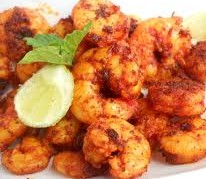 Prawns fry is an all time favorite among kids and elders too. Usually we prepare prawns curry as children enjoy the dish. They call it ‘buttons curry’ as the prawns curl into a circular pattern.
Prawns fry is an all time favorite among kids and elders too. Usually we prepare prawns curry as children enjoy the dish. They call it ‘buttons curry’ as the prawns curl into a circular pattern.
These days people have become very health conscious but indulging once a month is fine. The small variety prawns is an ideal choice for this recipe. Cleaning the small prawns is a pain but then the taste and the satisfaction that is seen on the faces of our loved ones after a meal makes us forget all the back pain and the tiring hours to get the prawns clean.
However our fish wala was helpful enough. He cleaned all the pods and even the vein (causes indigestion if not removed ). Usually after cleaning 1 kg of small prawns (with pod) the flesh quantity will be around 550 to 600 gms flesh. You can accordingly plan the quantity for your recipe.
I made it a point to check each prawn in the bowl. I washed it with lime juice and then the clean look was a green signal to start cooking.
I’m sharing a special prawns fry recipe generated from experiences in the kitchen. It has become a hit in our home and family too.
Ingredients :
Prawns: 250 gms (cleaned and de-veined)
Ginger garlic paste-1 table spoon
Chilli powder: 2 tsp
Turmeric powder: ½ tsp
Pepper powder: 1.5 tsp
Salt:1 tsp
Lemon juice: 1 lemon
Corn flour:2 table spoons
Cooking Oil: 1 cup
Procedure for preparing Special Prawns fry recipe:
Method:
- De-vein prawns ,wash them in lime juice and strain complete water
- Steam the prawns with 1/3 cup water, salt and turmeric powder.
- When the water is absorbed completely switch off the flame. Let the prawns cool down, then add the remaining ingredients except oil.
- Allow it to marinate for 30 mins.
- Shallow fry in hot oil and drain on an absorbent paper. You can add a few curry leaves in the oil to lend a nice aroma. Maintain medium flame and remove the prawns before it gets a dark color.
Do not deep fry as the prawns are already steam cooked. The corn flour added in the base will make the prawns crispy from the exterior and will remain soft inside.
Special prawns fry is a good combination with hot rice, tomato rasam prepared without dhal, papad or pickle.
Children have become so demanding that they actually check the quantity being served for each member.
Make this special prawn fry recipe and let your family enjoy the distinct taste of prawns. A look alike of a hotel dish.
Try making Fish pickle / meen achar
Prepare special Chettinad Kuzhi Paniyaram with left over dosa batter
June 3, 2014 by admin
Filed under Breakfast recipes
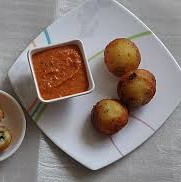 Special Chettinad Kuzhi Paniyaram is prepared with left over idli-dosa batter. A quick and healthy recipe. Consumption of oil is very less. The crispy Chettinad Kuzhi Paniyaram is in great demand. You can make use of the left over idli- dosa batter, be creative and your family is going to ask you for more numbers.
Special Chettinad Kuzhi Paniyaram is prepared with left over idli-dosa batter. A quick and healthy recipe. Consumption of oil is very less. The crispy Chettinad Kuzhi Paniyaram is in great demand. You can make use of the left over idli- dosa batter, be creative and your family is going to ask you for more numbers.
Kuzhi Paniyaram has various name like paddu, appe, guliappa, gulittu, gundponglu, ponganalu, and gunta pongadalu in various languages. The name kuzhi means a hole, the mould into which the batter is poured.
Ingredients :
Idli – Dosa batter: 2 cups
Shallots: 20 to 22 or 1 large onion
Green chilly: 3 nos
Urad dhal: 3 tsp
Mustard seeds: 1.5 tsp
Jeera: ½ tsp
Curry leaves:2 sprigs
Hing / Asafetida: 2 pinches
Fresh grated coconut: 3 tbsp
Fresh ginger: ½ tsp
Salt – 2 pinches
Oil: 8 tsp
Procedure for preparing Chettinad Kuzhi Paniyaram:
Method:
- Chop shallots, green chillies and curry leaves.
- Heat oil in a pan and add mustard, when they splutter add jeera, urad dhal. Roast till the dhal turns light brown. Lower flame and add asafetida.
- Continue to add the chopped shallots, green chilly and curry leaves.Add 2 pinches of salt and continue stirring. When the onions become translucent put off the flame.
- Add fresh grated coconut and finely chopped ginger. Mix well. It will get sauted in the heat of the pan.
- Transfer the contents in the pan to the batter. Mix well. No need to add salt as this is left over batter of idli -dosa.
- Heat the paniyaram pan, add few drops of oil in each mould. Pour the batter in each mould upto 3/4th level. Close the pan with a lid and allow this to cook at medium flame for 2 to 3 mins.
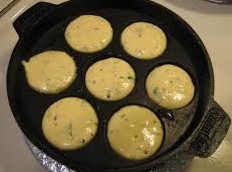
- Now turn each paniyaram in the pan upside down with a fork / spoon. If required pour a drop of oil on the mould. Let it remain for 2-3 mins, there is no need to place the lid.
- You will observe a crispy texture on the cooked side and a soft, spongy texture inside. Check if the batter has cooked by pricking a toothpick into the paniyaram, the stick should come out clean. Take off all the kuzhi paniyarams into a serving bowl.
- Now repeat the process to complete the batter. Serve hot Chettinad kuzhi paniyaram with roasted onion chutney or any chutney of your choice.
Ginger is an optional ingredient in the Chettinad kuzhi paniyaram. Including ginger in the batter gives a distinct aroma and is liked by elders in masala idli too. You can use onions in place of shallots ( sambhar onions) , the fact is that shallots add to the unique taste of chettinad kuzhi paniyaram.
This special Chettinad paniyaram can be prepared for breakfast or as a snack too. Oil consumption is less, cooked by steam and therefore a healthy breakfast.During festival time sweet paniyaram is made adding jaggery and banana.
Make use of your left over idli- dosa batter and let your preparation do the talking for you.
TANGY AND HEALTHY DATES CHUTNEY
April 28, 2014 by admin
Filed under Chutney varieties
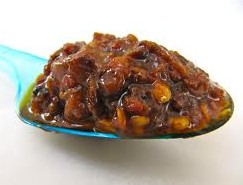 Dates chutney is a healthy recipe. Dates are delicious and one of the most popular fruits packed with an impressive list of essential nutrients, vitamins, and minerals that are required for normal growth, development and overall well-being. Available round the year, the recipe is simple and can be prepared with ease at home.
Dates chutney is a healthy recipe. Dates are delicious and one of the most popular fruits packed with an impressive list of essential nutrients, vitamins, and minerals that are required for normal growth, development and overall well-being. Available round the year, the recipe is simple and can be prepared with ease at home.
Fresh dates has soft, easily digestible flesh and simple sugars like fructose and dextrose. When eaten, they reload energy and revitalize the body instantly. For these qualities, they are being used to break the fast during Ramadan month since ancient times.
The recipe mentioned today is to make use of that delicious soft flesh of dates in a chutney .Read thru’ to understand how to make tangy and healthy Dates Chutney at home.
Ingredients :
Seedless dates: 15 nos
Green chilli: 1 tsp (finely chopped)
Red chilli powder: ½ tsp
Ginger: 1 tsp ( finely chopped)
Garlic: 4 cloves
Vinegar:4 tsp
Sugar: 1 table spoon
Turmeric powder: 2 pinch(s)
Fenugreek powder/ Methi powder: ¼ tsp(roasted and powdered)
Asafoetida / Hing: ¼ tsp
Water – ¼ cup
Salt: to taste
For Seasoning:
Oil: 3 tbsp
Curry leaves: 4 stems
Mustard seeds: ¼ tsp
Cumin seeds / Jeera: 1 pinch
Procedure for preparing tangy and healthy Dates Chutney:
Method:
- Cut the dates into small pieces. De-seed the dates if any.
- In a flat kadai add oil, when hot add curry leaves, mustard and cumin seeds, chopped green chillies,ginger and garlic. Saute on a medium flame for a minute.
- Minimize flame and add the powders to the base. Mix well and avoid burning at the base.
- Add vinegar and water to the base. Mix well and increase flame. When the mixture comes to a boil, add the salt and sugar. Reduce flame and keep stirring till the mixture is uniform.
- Switch off flame. Allow the chutney mix to cool.
- Serve this tangy and healthy dates chutney along with chapathi, dosa. Refrigerate for further use. Good for 2 months if dispensed with a dry spoon.
Health Benefits of eating Dates:
- Dates are extremely rich in minerals as well as Vitamins A, B1,B2,B3 ,C and K. They do not contain Cholesterol and other harmful fats.
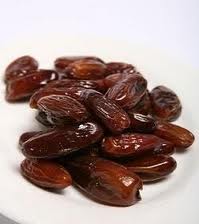
- Dates is rich in dietary fiber, which prevents LDL cholesterol absorption in the gut. Additionally, the fiber works as a bulk laxative.
- Dates contain health benefiting antioxidants known as tannins. Tannins are known to possess anti-infective, anti-inflammatory, and anti-hemorrhagic properties i.e it prevents easy bleeding tendencies
- Dates are an excellent source of iron. Iron, being a component of hemoglobin inside the red blood cells, determines the oxygen-carrying capacity of the blood.
- Dates are very good in potassium. Potassium is an important component of cell and body fluids that help controlling heart rate and blood pressure. Thus consuming dates offers protection against stroke and coronary heart diseases.
- Dates are also rich in minerals like calcium, manganese, copper, and magnesium. Calcium is an important mineral that is an essential constituent of bone and teeth, and required by the body for muscle contraction, blood clotting, and nerve impulse conduction. Manganese is used by the body as a co-factor for the antioxidant enzyme. Copper is required for the production of red blood cells. Magnesium is essential for bone growth.
Go ahead and try the tangy dates chutney that can be served along with rice / chapathis. Can be stored for 2 months by dispensing with a dry spoon.
If you like this recipe or know of any variations do let us know in the comments.
TAMARIND RASAM RECIPE WITHOUT TOMATO AND DAL
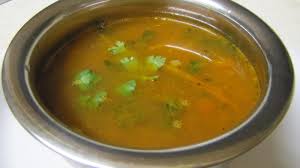 Rasam is popular among South Indians .Tamarind rasam is ideal when you are feeling down and need an energy boost. Rasams are made in different styles in different parts of South India. Addition of dhal or tomato is commonly seen in preparation. Basic ingredients are tamarind pulp, tomato and rasam powder.
Rasam is popular among South Indians .Tamarind rasam is ideal when you are feeling down and need an energy boost. Rasams are made in different styles in different parts of South India. Addition of dhal or tomato is commonly seen in preparation. Basic ingredients are tamarind pulp, tomato and rasam powder.
In a formal meal, the rasam course is served after the sambhar course and followed by curd rice. Served to eat with rice or few people enjoy drinking the light soup by itself. Rasam is consumed as an appetizer before the beginning of a meal.Rasam can be considered daily, a mandatory curry in most homes.
Today I’m sharing a tamarind rasam recipe without tomato and dal. The recipe is simple and can be followed with ease. This rasam is ideal during winter and cold evenings.
Ingredients :
Tamarind: Medium Lemon sized ball
Garlic cloves: 3 to 4 nos (crush them lightly)
Fenugreek seed powder(Methi / Menthulu): ¼ tsp
Turmeric powder: ¼ tsp
Pepper powder: 1.5 tsp
Salt ( to taste)
Asafoetida (Hing): 2 pinches
For seasoning:
Mustard seeds: 1 tsp
Cumin seeds( Jeera): 1 tsp
Curry leaves: 1 stalk
Dry red chillies: 2 nos
For garnishing:
Chopped coriander leaves : 2 tbsp
Procedure for preparing Tamarind rasam without tomato and dal:
Method:
- Soak tamarind in 1 cup water for 30 mins. Strain the pulp by adding water.
- Heat oil in a kadhai and add mustard seeds. Add garlic pods, cumin seeds, curry leaves, dry red chilies.
- Saute a while and add pepper powder, Fenugreek seed powder and asofoetida. Add tamarind water along with squeezed pulp.
- To this add 1 cup water and turmeric powder.
- Mix the watery solution, add salt as per taste. Cook till it boils.
- Garnish with chopped coriander and serve with steamed rice.
The pepper aroma will be strong and smells perfect. Remembering the catchy words of a popular ad: Ee rasam bahu kemam (this rasam taste excellent)
Benefits of having Rasam:
- Rasam when had at the beginning of the meal is said to increases the appetite.
- Rasam contains many spices which are considered beneficial to health.
- Steaming hot rasam is soothing when you are suffering from a cold, cough or sore throat.
- When you have a headache plan for a rasam preparation, it will relieve your headache.
- Rasam is served to the person who is sick with fever and has no appetite and feels tastelessness in the mouth, it not only increases the appetite but also the spices in the rasam hit the mouth and throat increasing the taste in the mouth.
If you like this recipe or know of any variations do let us know in the comments.
Summer special recipes for further reading: Buttermilk, Ragi Java, Green Mango drink, Pudina Pani
UGADI PACHADI
March 31, 2014 by admin
Filed under Chutney varieties
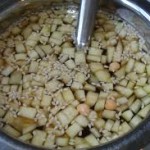 Ugadi Pachadi is made on the auspicious occasion of Ugadi. Ugadi marks the beginning of the Telugu New Year. This festival brings happiness with the beginning of Vasanth Ruthu (Spring season). Ugadi pachadi is a mandatory preparation in all Telugu homes. This pachadi consists of 6 tastes also known as Shadruchulu i.e Sweet, Sour, Bitter, Salty, Spicy-Hot and pungent.
Ugadi Pachadi is made on the auspicious occasion of Ugadi. Ugadi marks the beginning of the Telugu New Year. This festival brings happiness with the beginning of Vasanth Ruthu (Spring season). Ugadi pachadi is a mandatory preparation in all Telugu homes. This pachadi consists of 6 tastes also known as Shadruchulu i.e Sweet, Sour, Bitter, Salty, Spicy-Hot and pungent.
This is an easy recipe not requiring great skills. The right proportions in addition of ingredients will bring up that taste that will bring in nostalgic memories of childhood days.
Ingredients:
Neem flower petals: 2 tea spoons
Raw Mango: 2 Table spoons (finely chopped)
Tamarind: Small lemon size ball
Green chillies: ½ tspn finely chopped
Salt: ¼ tspn
Jaggery: ½ cup powdered
Water: 3 cups
Ripe Banana: 1 no. chopped
Putnal pappu / Fried chick pea: 2 table spoons
Procedure for Ugadi Pachadi:
- Separate the petals from the flowers by rubbing them between your palms. Sieve and collect only the petals of the neem flowers. Wash and keep aside
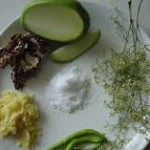
- Soak tamarind in 1 cup warm water for 20 minutes. Add 2 cups of water and dilute it to a thin, watery mix.
- Heat putnal papu and keep aside.
- Add rawmango pieces, neem flower petals, salt, green chilles, grated jaggery. Mix well till jaggery dissolves completely. Then add cut banana and roasted putnal pappu.
- Serve chilled for the youngsters who tend to be fussy over the taste. Use water stored in earthern pot (Kunda) such that the temperature is suitable for elders while serving Ugadi Pachadi at your home.
Homemade katti meethi Ugadi Pachadi is ready to serve.
Few areas in andhra do add roasted Sesame(til) and crushed saunf (fennel)
Special dishes like Pulihora, Bobbatlu- Puran Poli and Payasam is served .Learn to make special laddoos this Ugadi for your family and dear ones.
HAPPY UGADI….Wishing all prosperity ….UGADI SUBHAKANKSHULU
“U” thsavam – Festival
“G” owravam – Respect
“A” anandam – Happiness
“D” hanam – Money
“I” shwaryam – Prosperity
“UGADI” Shrikara Nama Samvatsra Shubhakankshalu!
WHEAT STEAM CAKE-GOTHAMBU PUTTU
March 18, 2014 by admin
Filed under Breakfast recipes
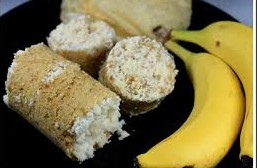 Wheat steam cake is a special breakfast in Kerala, popularly known as Gothambu puttu or Wheat puttu. Due to health reasons people are avoiding rice flour breakfast and switching over to wheat flour recipes, oats recipes as this is healthy and filling too. People with diabetes will not feel hungry till noon. Wheat steam cake is a healthy breakfast which can be made easily at home.
Wheat steam cake is a special breakfast in Kerala, popularly known as Gothambu puttu or Wheat puttu. Due to health reasons people are avoiding rice flour breakfast and switching over to wheat flour recipes, oats recipes as this is healthy and filling too. People with diabetes will not feel hungry till noon. Wheat steam cake is a healthy breakfast which can be made easily at home.
I learnt this recipe as my in-laws were diabetic and I wanted to avoid rice flour in the breakfast menu. The preparation is easy, you require a puttu maker or a steel sieve like utensil with large holes. This can be placed over a wide bowl such that all steam passes thru’ the sieve and the puttu is steam cooked.
We have a puttu maker so that we get a long cylindrical steam cake in our plates. When served hot they enjoy it. You can certainly give a try.
Ingredients :
Wheat flour: 1 cup
Grated coconut: ¼ cup
Salt: 2 pinches ( to taste)
Water: 1/3 cup or sufficient to wet the powder.
Accessory required: Puttu maker
Procedure for preparing Wheat Steam cake – Gothambu puttu:
Method:
- Dispense wheat flour in a wide kadai. Dry roast wheat flour over medium flame stirring continuously until the powder feels warm when touched with your palm.
- Watch out for the powder not to catch the base.
- Remove from flame and allow wheat flour to cool.
- Sprinkle lukewarm water on the powder and stir the powder thoroughly. You will observe small lumps. Continue sprinkling little water till all the dry powder has formed small fine lumps.
- Ensure the powder has not become sticky. The right check for consistency is when you hold a fistful of powder it forms a shape and stays together, when you press the ball it falls apart.
- Transfer this wet powdery lumps into a mixer and inch it 2-3 times. This will remove all lumps and give a uniform puttu base.
- Place the puttu maker on the flame and when steam starts releasing from the vent holes, remove the puttu holder from the pot.
- Fill the ingredients layer wise. Fill grated coconut, prepared wheat flour, and repeat this filling once more. The last layer should be grated coconut.
- Fill contents loosely .Do not compress the wheat flour into puttu maker.
- After 6-8 mins of continuous steam releasing thru the vent the wheat steam cake is ready to serve.
- Gently push the steamed wheat puttu onto a plate. Ideal combination is with small banana (pazham) and sugar.
Diabetic patients can enjoy gothambu puttu with pappadam, cooked moong gram, Kadala curry. Few enjoy wheat puttu without any additions. They prefer it hot. The fresh coconut which blends with the gothambu puttu gives that extra taste factor.
A suitable alternative if you do not have a puttu maker is a kadai in the bottom with a wide sieve placed on top to grab all the steam. Spread coconut at the base then prepared wheat flour and again repeat this layer 1 time. Ensure the spread is loose and not compressed. Close the sieve with a large plate to avoid steam loss.
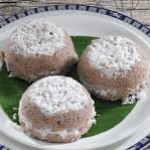
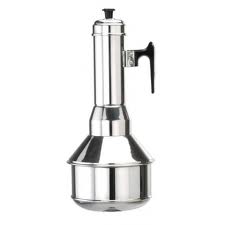 Wheat puttu is a healthy breakfast and can be made easily at home. Have a healthy start. There are other variations like rice puttu, ragi puttu, oats puttu,rava puttu.
Wheat puttu is a healthy breakfast and can be made easily at home. Have a healthy start. There are other variations like rice puttu, ragi puttu, oats puttu,rava puttu.
If you like this recipe or know of any variations do let us know in the comments.
How to make Ginger- Garlic paste at home
March 4, 2014 by admin
Filed under How to make...for beginners
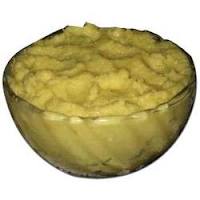 Ginger garlic paste is an indispensable ingredient in every Indian Kitchen. Most of the curries call for ginger garlic paste. All the more for the non vegetarians. You can make fresh ginger garlic paste at home. Homemade ginger garlic paste is the best as it is fresh and you are sure there are no artificial flavors and hygiene factors are maintained too.
Ginger garlic paste is an indispensable ingredient in every Indian Kitchen. Most of the curries call for ginger garlic paste. All the more for the non vegetarians. You can make fresh ginger garlic paste at home. Homemade ginger garlic paste is the best as it is fresh and you are sure there are no artificial flavors and hygiene factors are maintained too.
I make the paste during weekends and therefore I’ have stock for 2 weeks at east. The procedure is very simple requiring some pre-work. The pre-work is time consuming , the results are great. The purchased ginger garlic smells different with a color tinge too. Therefore replicate the process of preparing ginger garlic paste at home.
The basic ingredients are Ginger and garlic. Add salt while grinding. Salt will act as a preservative during storage and will help retain freshness. Soak ginger in water for 10 mins to remove soil and color. Peel ginger skin after draining water. Recycle the muddy water in the potted plants. Peel garlic to avoid strands in the paste.
Tips to peel garlic:
Separate garlic pods and then apply a little vegetable oil and place it in the sun for an hour. The garlic needs to be pushed at the top side and the peel can be separated. I usually do garlic peeling while watching television. You will not realize the effort as you will be engrossed watching the show. Included humor…..
Watch out for the kids not switching ‘ON’ on the ceiling fan without informing you. The entire room will be spread with garlic peel. The other source can be the wind blowing from the window. Ingredients :
Ginger: 100 gms
Garlic :100 gms
Salt: ½ tsp
Procedure for preparing Ginger garlic paste at home:
Method:
- Wash, rinse and peel ginger. Drain water and chop into pieces.
- Peel garlic. Chop the garlic pods if large.
- In a mixer add chopped ginger and garlic pods. Add salt and grind to a fine paste.
- You can add 2 to 3 tspns of water if the contents are not freely moving in the mixer.
- Transfer contents to a clean dry bottle or box.
- Dispense with a clean dry spoon. Place the bottle in the refrigerator always.
- Shelf life is 3 to 4 weeks if placed in the refrigerator.
- If placed out for more than an hour the color changes also giving an aged smell.
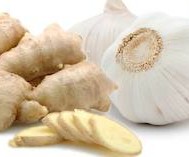 Salt addition while grinding ginger garlic is a tested and sure way for long storage. People do add oil, turmeric powder to keep ginger garlic paste fresh
Salt addition while grinding ginger garlic is a tested and sure way for long storage. People do add oil, turmeric powder to keep ginger garlic paste fresh 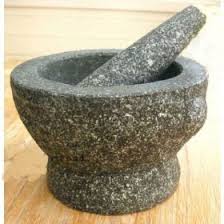 At times I prefer to add freshly minced ginger garlic especially for non vegetarian dishes. I have a grinding stone to crush ginger and garlic as per requirement.
At times I prefer to add freshly minced ginger garlic especially for non vegetarian dishes. I have a grinding stone to crush ginger and garlic as per requirement.
HOW TO MAKE THICK CURD
January 29, 2014 by admin
Filed under How to make...for beginners
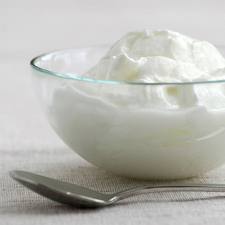 Preparing curd is an art by itself. Indian homes are very used to having curd/ yoghurt also called dahi along with meals. In South India curd is consumed at the end of the meal be it lunch or dinner. Fresh curd is in great demand.
Preparing curd is an art by itself. Indian homes are very used to having curd/ yoghurt also called dahi along with meals. In South India curd is consumed at the end of the meal be it lunch or dinner. Fresh curd is in great demand.
Yogurt is a fermented milk product produced by bacterial fermentation of milk. The bacteria used to make yogurt are known as “yogurt cultures“. Fermentation of lactose by these bacteria produces lactic acid, which acts on milk protein to give yogurt its texture and its characteristic taste.
An old myth regarding curd
Curd is tasty when fresh and it is not sour (pulla / pulippa) . Starter yoghurt is called Ora /thodu. There is a myth that starter curd/ ora/ thodu should not be borrowed from another home at night. When there was a need for going to neighbors house for starter curd, my granny used to remind that it was not the right time to borrow. Grandma would continue saying that you should not borrow salt and sarso i.e mustard seeds from anyone. It will convey poverty or daaridram i.e financially poor status. This tradition of borrowing starter curd continues in modern times because it is natural and not induced.
These were few old memories. Now that we have groceries and super markets at every lane in the localities be it urban or rural, buying commodities can be planned any time of the day.
Tips for preparing curd :
Do not add starter curd to hot milk. The bacteria will die and the milk will get curdled…appearance of split milk. Ensure the milk is lukewarm temp app. 45 deg C. Check point is when you dip your finger into the milk (ready for preparing curd) it should be feel warm. The curd will set in the shape of the container you dispense into. You can cut thru’ the curd while serving.
I’ll share the benefits of curd after I share the easy recipe of making thick curd at home.
Ingredients :
Starter curd / Thodu: 1 tbsn heaped
Milk: 2 cups
Procedure for making thick curd:
- Boil milk .Lower the flame and let it continue boiling for 3 to 4 mins.
- Allow the milk to cool down to lukewarm temp. Higher temperatures will split the milk and it will have a curdled appearance with an odd taste.
- Dispense the starter curd into a glass and add ½ cup of milk and mix thoroughly with the spoon.
- Now transfer the quantity from one glass to the 2nd glass, back to back 4 to 5 times. The process is similar to cooling tea which is seen in tea shops. The vendor transfers the tea from one jug to another jug and repeat this 3 to 4 times, the tea will be of right temp to drink also giving a foamy appearance on top of the glass.
- The starter curd gets thoroughly mixed with milk. Keep the utensil closed and undisturbed for 4 hours. Setting is quick in summer due to external temp and heat. In winters you need to provide at least 6 hrs setting time.
- You can leave a red dry chilly along with stem over the curd. This will also help curd set faster.
You can make several recipes with curd. Common recipes are: Butter milk, Lassi, Raitha, Curd rice, Kadi etc. Curd is added in chicken preparations eg: chicken curry, manchuria, used for making cake.
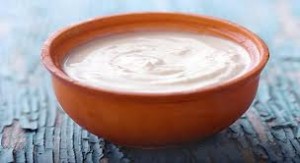 Benefits of curd:
Benefits of curd:
Curd improves appetite when taken along with sugar and salt, actually stimulates the taste buds. Curd quenches thirst too. By-products like lassi and buttermilk are popular drinks at summer.
Curd is good for digestive system, immune system, osteoporosis, stomach problems and cures vaginal infection.
Curd is enjoyed by people of all ages. Do you know preparing curd without starter curd i.e thodu. Give your inputs on this query, article in the comments.









